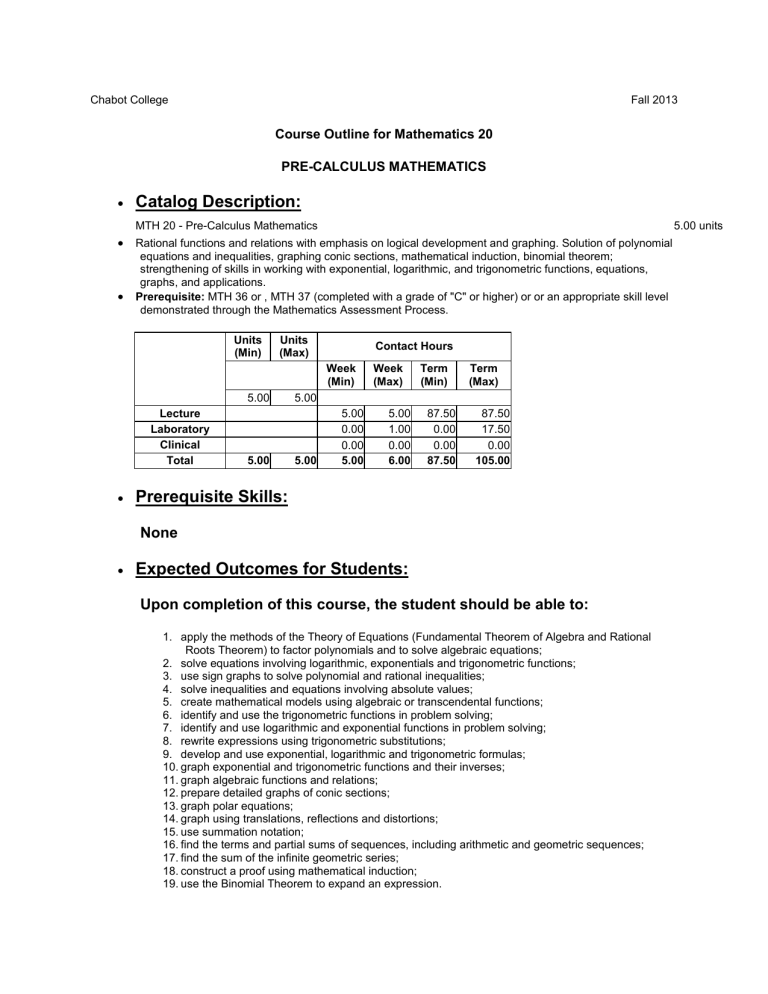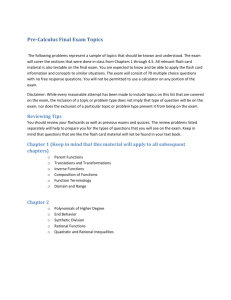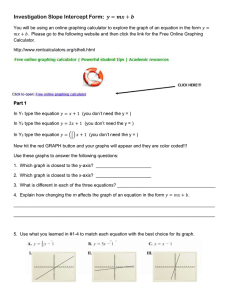Catalog Description: Course Outline for Mathematics 20 PRE-CALCULUS MATHEMATICS •

Chabot College Fall 2013
Course Outline for Mathematics 20
PRE-CALCULUS MATHEMATICS
•
Catalog Description:
MTH 20 - Pre-Calculus Mathematics
•
Rational functions and relations with emphasis on logical development and graphing. Solution of polynomial equations and inequalities, graphing conic sections, mathematical induction, binomial theorem; strengthening of skills in working with exponential, logarithmic, and trigonometric functions, equations, graphs, and applications.
•
Prerequisite: MTH 36 or , MTH 37 (completed with a grade of "C" or higher) or or an appropriate skill level demonstrated through the Mathematics Assessment Process.
5.00 units
Lecture
Laboratory
Clinical
Total
Units
(Min)
Units
(Max)
Contact Hours
Week
(Min)
Week
(Max)
Term
(Min)
Term
(Max)
5.00 5.00
5.00 5.00 87.50 87.50
0.00
0.00
1.00
0.00
0.00
0.00
17.50
0.00
5.00 5.00 5.00 6.00 87.50 105.00
•
Prerequisite Skills:
None
•
Expected Outcomes for Students:
Upon completion of this course, the student should be able to:
1. apply the methods of the Theory of Equations (Fundamental Theorem of Algebra and Rational
Roots Theorem) to factor polynomials and to solve algebraic equations;
2. solve equations involving logarithmic, exponentials and trigonometric functions;
3. use sign graphs to solve polynomial and rational inequalities;
4. solve inequalities and equations involving absolute values;
5. create mathematical models using algebraic or transcendental functions;
6. identify and use the trigonometric functions in problem solving;
7. identify and use logarithmic and exponential functions in problem solving;
8. rewrite expressions using trigonometric substitutions;
9. develop and use exponential, logarithmic and trigonometric formulas;
10. graph exponential and trigonometric functions and their inverses;
11. graph algebraic functions and relations;
12. prepare detailed graphs of conic sections;
13. graph polar equations;
14. graph using translations, reflections and distortions;
15. use summation notation;
16. find the terms and partial sums of sequences, including arithmetic and geometric sequences;
17. find the sum of the infinite geometric series;
18. construct a proof using mathematical induction;
19. use the Binomial Theorem to expand an expression.
•
Course Content:
1. Functions, relations and their graphs
A. Algebraic functions, including polynomial and rational
B. Algebraic relations
C. Graphing techniques
D. Algebra of functions
E. Inverse functions
F. Modeling and applications
2. Inequalities
A. Review linear
B. Absolute value
C. Non-linear
D. Solutions
E. Graphs
3. Mathematical induction
A. Summations algebra
B. Counting principle
C. General distribution property
D. Sequences and series
4. Binomial Theorem
5. Conic Sections using analytic geometry
A. Equations
B. Graphing, including translation
6. Roots of polynomial equations
A. Division of polynomials
B. Fundamental theorem of algebra
C. Remainder theorem
D. Rational roots theorem
E. Complex roots
7. Exponents and logarithms
A. Exponential and logarithmic functions and graphs
B. Properties of exponents and logarithms
C. Solving equations
D. Modeling and applications
8. Trigonometry
A. Trigonometric functions and graphs
B. Inverse trigonometric functions and their graphs
C. Trigonometric formulas and identities
D. Solving equations
E. Modeling and applications
9. Polar coordinates and graphs
•
Methods of Presentation
•
1. Lecture/Discussion
2. Demonstration/Exercise
3. Problem solving sessions
Assignments and Methods of Evaluating Student Progress
•
1. Typical Assignments
A. Exercises from the textbook: The population of a certain city was 112,000 in 1994, and the observed relative growth rate is 4% per year. 1) Find a function that models the population after t years. 2) Find the projected population in the year 2000. 3) In what year will the population reach 200,000?
B. Collaborative: Perform an experiment with view tubes and model with a rational function
2. Methods of Evaluating Student Progress
A. Exams/Tests
B. Quizzes
C. Home Work
D. Final Examination
Textbook (Typical):
1. Zill, D., G. Dewar, J., M. (2013). Precalculus with Calculus Previews (Fifth/e). Jones and Bartlett
Learning.
•
Special Student Materials
1. Either scientific or graphing calculator





